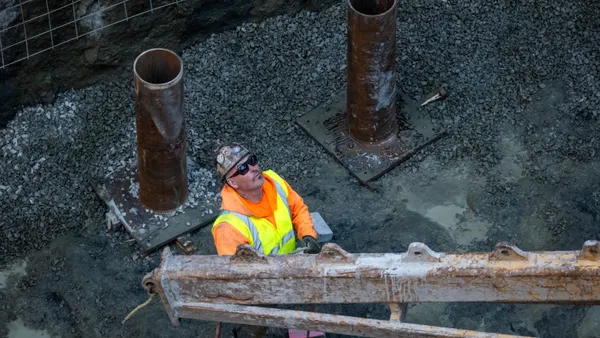Dive Brief:
- The National Association of Homebuilders, as part of its monthly NAHB/Wells Fargo Housing Market Index survey, has found that single-family builders are having a harder time finding skilled labor and subcontractors than they were a year ago.
- The survey addressed nine trades, and the percentage of companies reporting a shortage has increased from 21% in 2012 to a current share of 56%, up 10% from 2014 and 4% from last year.
- NAHB survey respondents said they were having the most trouble finding critical carpentry workers, both rough (72%) and finish (70%), as well as framers (68%) bricklayers (57%), painters (50%), electricians (48%), plumbers (47%), roofers (45%), excavators (44%) and HVAC technicians (42%).
Dive Insight
The NAHB noted that the current shortages, which vary across the country, seem to be more severe than past ones, especially in the face of fewer single-family home starts — 1.1 million — than in previous years.
Even more scarce, however, are subcontractors in the most critical trades, with rough carpentry (78%), framing (78%), finish carpentry (73%), bricklaying (67%), plumbing (56%), roofing (55%), painting (54%), electrical (55%), excavating (53%) and HVAC (48%) crews being the hardest to find. Subcontractors typically make up more than 75% of the labor on a single-family home, so builders are paying available subcontractors a premium, which is causing an increase in home prices and schedule delays.
According to the latest labor report from the Associated General Contractors of America, the lack of skilled labor in the U.S. has limited construction hiring and will soon begin to impact the general economy. The NAHB also reported earlier this month that unfilled construction positions remained at a near post-recession-high of 200,000.
Construction employment has seen a sudden slowdown in the recent months after job numbers skyrocketed in the first three months of the year. However, along with those strong employment gains, experts warned that employers were draining the pool of existing talent and running out of people to hire. Those predictions were realized in May, when construction lost 15,000 jobs. The labor shortage has led some experts to suggest supporting new marketing efforts, a greater focus on technical training in school, immigration reform and a broad coalition effort as possible solutions.












